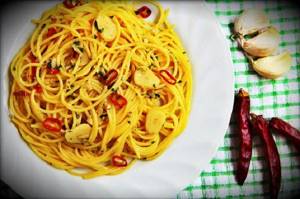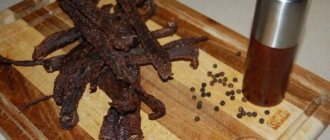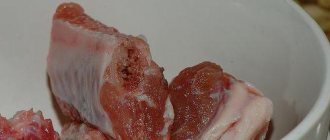How to remove bitterness in the ear from the head. How to remove bitterness from fish soup if there is bile in it recipe
Fish soup is a real delicacy that is associated with a hearty family dinner or pleasant gatherings around the fire. However, reality does not always correspond to expectations: sometimes the finished dish is bitter and cannot be eaten with pleasure. How to remove bitterness from fish soup and how to do it correctly so as not to be disappointed in the taste? Let's figure it out.
How to remove bitterness from fish soup? One way is to squeeze lemon into it.
- Number of servings:1
- Cooking time:20 minutes
How to masterfully remove bitterness from fish soup?
Unpleasant bitterness appears in the soup if you cut the fish incorrectly or wash it poorly or do not fully follow the cooking algorithm. Let's take a step-by-step look at how to make a culinary masterpiece:
- In order not to wonder how to remove bitterness in the ear, it is necessary to properly carry out the initial processing of the fish. Remove the scales, then cut off the head and fins. If you prefer to cook the product with its head, be sure to remove the gills: they can give the soup an unpleasant aftertaste. Under no circumstances leave the eyes out: they will make the broth cloudy. The “finishing touch” is to remove the skin, open the belly and gut the carcass.
- When cleaning the insides of the fish, do not damage the gall bladder: its contents can cause unpleasant bitterness. Rinse the belly thoroughly and sprinkle with lemon juice to be safe. Only in this prepared form can the fish be placed in the pan.
- Initially, fish, chopped onions and parsley root are placed in cold water (it gives a pleasant smell). Everything is cooked for one hour. Spices should be added to the broth later: 10-15 minutes before it is supposed to be ready.
- To make the soup light, you can add caviar to it. Take 50 g of the product and dilute with cold water. Pour into the pan gradually, stirring constantly. Then let the soup boil.
- After boiling, you need to remove the lid and boil the fish soup for about a quarter of an hour. Then it should stand under the lid for the same amount of time so that it “reaches” the taste. Try the finished soup: if it is completely successful, pour into portioned bowls and serve. Place a piece of fish on each plate.
If strictly following the cooking algorithm did not help you create a product that tastes perfect, use simple advice on how to remove bitterness from fish soup broth. Cut half a lemon and squeeze the juice into the finished dish. Cover with a lid and leave to steep for a quarter of an hour. After this, the unpleasant aftertaste should disappear, the soup will become tender and acquire a wonderful aroma.
Fish soup is one of the favorite dishes of fishermen. How nice it is to sit by the fire, stirring the delicious richness in the pot. But sometimes you find that this dish is not so tasty if the broth is bitter. So that the ear does not become bitter. It must be prepared according to certain rules.
Choose your recipe
You will need
- 1 kg fresh fish
- 2 medium onions
- 4 cloves garlic
- parsley root
- Bay leaf
- allspice and peas
- salt (preferably rock salt)
- saucepan or kettle
- water 2.5 liters
Instructions
Before you start making fish soup
, decide what kind of fish you will use.
Ruff and perch are best suited for classic fish soup Be sure to rinse the fish with clean water.
If you are using very small fish, then it is not necessary to gut it, but medium-sized fish need to be gutted and washed again. Don't forget to completely remove the gills - they give the ear its appearance.
Be sure to remove the eyes - they will make the broth cloudy.
Place the prepared fish in a saucepan or kettle, cover with cold water, add peeled roots, coarsely chopped onion and simmer over low heat for 40-60 minutes.
10 minutes before the end of cooking, add bay leaf, pepper and salt. After 10 minutes, strain the finished broth. If you want to lighten the broth, add pressed or black granular caviar.
To do this, grind 50 g of caviar in a mortar, gradually adding cold water.
Ultimately, you need to dilute the caviar in a glass of cold water, then add a glass of hot fish soup
, stir and pour gradually into the pan with the fish soup: after pouring in the first portion, the fish soup should boil, then pour in the rest.
When the soup boils again, remove the lid and simmer over low heat for 15-20 minutes, then turn off the heat and let the soup stand for 10-15 minutes.
Before serving the fish soup, strain it, pour into plates and add a piece of boiled fish.
note
If you want to prepare fish soup from small fish, it is better not to use crucian carp, rudd and roach - the fish soup from them will not be as tasty and rich. And remember that real classic fish soup is cooked over a fire.
Helpful advice
To enhance the taste and aroma, add a little vodka or cognac to your ear. If you want to prepare a “double” fish soup, then add fillets of larger fish, such as pike perch, cut into portions, to the prepared and strained broth from small fish. Cook for another 20 minutes.
Everyone has encountered a situation where the finished dish does not meet expectations. In this article we will look at the question: it’s bitter, what should you do to save the dish?
Bitter ear: what to do
Important: in order not to look for a way out of this situation, try to prevent it. To do this, at the stage of preparing food, pay maximum attention to cutting the fish. Incompletely removed black films, gall bladder burst during cutting, as well as gills are the main causes of bitterness. It is better to cut out the gills, then the problem of bitter fish soup will not affect you.
The fish should be filled with cold water and cooked after boiling only over low heat.
If the soup still tastes bitter, you can do the following:
- Take a large onion, cut it into two parts, put it in a saucepan, cover with a lid and leave for 15 minutes. Then discard the bitter onion.
- Take half a lemon, squeeze out the juice, pour it into the pan with the prepared fish soup. After 15 minutes, you can taste the finished dish - the bitterness will disappear from it without a trace.
- Another recipe - we use greens. In a standard saucepan, take a bunch of your favorite herbs - dill, cilantro or parsley. Grind, add to the pan, leave for a quarter of an hour. This method helps if the bitterness is medium or weak.
Important: if it is too bitter, try a combination: first use onions, and then add a lot of herbs to the dish.
Ukha is a delicious fish dish, although it is probably not a frequent guest on your table. That’s why they love her, because she doesn’t have time to get bored.
Fish soup can be prepared with almost all types of fish, except roach, since it gives off bitterness.
Before answering the question of how to get rid of bitterness in the ear, you need to understand why the ear is bitter.
Why does my ear taste bitter?
The fish soup will taste bitter if you cleaned the fish incorrectly or did not follow the cooking technology.
How to properly clean fish so that the fish soup does not taste bitter later?
1. Clean the fish from scales, then cut off the head and fins. If you use the head when preparing a delicious rich fish soup, be sure to remove the gill!!! (since they are the ones who can give all the bitterness to your ear).
2. Then carefully open the belly, using a sharp knife without penetrating deeply, so as not to damage the gall bladder, which gives bitterness. Then carefully remove all the insides from the fish and rinse the fish with water. To be safe, you can sprinkle the insides of the fish with lemon. Now the fish is ready to prepare a delicious fish soup.
But it happens that, for unknown reasons, the fish soup tastes bitter, even though the fish was cleaned correctly and seemed to be cooked the same way.
How to remove bitterness from fish soup?
You can fix the situation using . To do this, squeeze the juice of half a lemon into the pan. Let the soup brew for about 15 minutes and taste the broth. The bitterness should disappear, and your ear will have a spicy and slightly sour taste.
How to cook fish soup correctly?
Place fish, coarsely chopped fish, and parsley root for flavor. 10 minutes before cooking, add pepper, salt and bay leaf to the broth. To make the broth light or transparent, add a little caviar to it. When the broth is ready, strain it and put it back on the fire. Leave the fish on the plate, add when the potatoes are cooked.
Source: https://stale.ru/podberezoviki/chem-ubrat-gorech-v-uhe-iz-golovy-kak-ubrat-gorech-iz-uhi-esli-popala/
A dish that was salted twice
If such a problem occurs, then you need to remember a simple principle: salt dissolves perfectly in water. This means that its excess in a dish can be corrected by adding liquid.
It happens that it is possible to find out about excess salt when the dish is already ready and is not liquid. We are talking about pasta, rice, buckwheat and boiled vegetables. To return such products to their normal taste, you need to place them in warm water for 10-15 minutes. This is enough to remove excess salt.
In the case of salads without sunflower oil or mayonnaise, you can also use a similar method.
The star of the series “Sultan of My Heart” spoke about the choice of his future wife
The newlyweds traveled all over the world and took wedding photos in every country
A broken nail is no problem: tips for treating nails at home
But if the broth turns out to be too salty, you cannot add water. Another method that is effective for this problem is to place rice or potatoes in a gauze bag and lower them into a pan with broth, then boil for 20 minutes. Then everything is taken out. The dish gets rid of excess salt.
Over-salted dough can only be restored with unleavened dough. These two separate masses are mixed and left for 30 minutes.
It happens that French-style meat turns out to be over-salted, as well as fish or vegetables stewed in foil. In this case, you can restore the taste using three ingredients, such as:
- tomato sauce;
- tomatoes;
- sour cream.
You can pour over-salted meat or fish with any of these products: tomatoes whipped in a blender or sour cream sauce. It is advisable to add spices. The taste will change slightly, but the excess salt will be neutralized.
Why is my ear sour?
This fish soup recipe is considered a recipe for real fish soup, well, that’s how we consider it, i.e. in my social circles with fellow fishermen.
We use perches. You need to wash them thoroughly, remove the bile, and remove the giblets. The fish is placed in a pan unpeeled, with scales. The scales from boiled fish are quickly and easily removed. You need to cook on low heat. When the lenses of the perch's eyes turn white, it means the fish is ready. Next, you need to season the broth with onions, peppers, bay leaves and other spices to taste.
https://www..com/watch?v=
Speaking of bile, I’ll write a few words about it.
How to remove the taste of bile in fish
Bile imparts bitterness to fish, so it is advisable to remove it before cooking fish.
- Carefully cut the fish so as not to cut its liver and gall bladder. To do this, place the fish on its side on the board, and the belly mode is not deep. Do not cut the fish in half, as this is more likely to damage the liver.
- If, nevertheless, bile spills, then you need to soak the fish in water, treat with salt, and then rinse in cold water. To remove bile, you can use regular table vinegar; apple cider vinegar is recommended. After cleaning, rinse the fish thoroughly, then coat the belly with vinegar, then rinse off the vinegar and soak the fish in cold water.
- If you detect the taste of bile in already cooked fish, it is recommended to season the dish with fresh, aromatic herbs (parsley, celery).
Fish is a very valuable and healthy food product. It contains many substances necessary for the human body. Fish dishes are easy to digest, go well with many types of side dishes, and are lower in calories compared to meat dishes.
Fish is especially useful for children and the elderly. But what should you do if, while cleaning fish, you inadvertently crushed the gallbladder or found yellow stains on the purchased fish that form when bile spills. After all, the dish can become bitter.
How to remove the taste of bile from fish?
You will need it
When you start processing caught or purchased fish, follow a few common rules. Clean it, cut off the head and tail fin with a small section of the carcass with a sharp knife, put it in a separate container (from these parts of the fish you can cook a good fish soup).
Remove the other fins, place the fish on its side on a cutting board and, using the tip of a knife, make a long, shallow cut starting from the anus.
Through this incision, carefully remove the entrails, being careful not to destroy either the gallbladder or the liver.
Use a very sharp knife, and try to make the cut really shallow, because in some species of fish the gall bladder is located close to the surface of the abdomen.
If you do damage the gallbladder, immediately cut out the area of the carcass on which the bile has spilled, and rub the adjacent areas with small table salt. After this, carefully wash the fish in running cool water. For greater reliability, after removing the affected area, soak the fish in cool water for 1.5-2 hours, and then treat with salt and wash.
Have you found yellowish stains on the fish you purchased? In this case, use a sharp knife to cut off the affected areas and discard.
Thoroughly wash the carcass in running cool water, then treat with 9% table vinegar. Wash the fish again and place in a deep bowl or pan filled with water for 1.5-2 hours.
If you have vinegar with a milder taste and smell, for example, apple or rice, it is better to use it.
To remove the taste of bile in fish, you can also use lemon juice, but only if the yellowish stains are relatively small in size. If they have affected a fairly large surface of the fish, it is better to use vinegar, it is more reliable.
What if the corresponding bitter taste and nasty smell of bile are still felt in the finished fish dish? Then, the only method is to try to “mask” them by adding a fragrant side dish with a strong and persistent taste to the dish. Fresh herbs, such as leaf parsley, are best suited for this.
What to do if the gall bladder bursts in fish
Fish is a very valuable and necessary food product. It contains a huge amount of substances needed by the human body. Fish dishes are easy to digest, mix well with many types of side dishes, and have the least amount of calories compared to meat dishes.
Fish is especially useful for children and old people. But what should you do if, while cleaning the fish, you inadvertently crushed the gallbladder or found yellowish stains on the purchased fish that form when bile spills. After all, the dish can become bitter.
How to remove the taste of bile from fish?
https://www..com/watch?v=fc66rEiKMH0
Have you found yellowish stains on the fish you purchased? In this case, use a sharp knife to cut off the affected areas and discard.
Thoroughly wash the carcass in running cool water, then treat with 9% table vinegar. Wash the fish again and place in a deep bowl or pan filled with water for 1.5-2 hours.
If you have vinegar with a milder taste and smell, for example, apple or rice, it is better to use it.
Source: https://alfito.ru/pochemu-gorchit-ukha/
Overcooked meals
If the pasta cooking on the stove is forgotten, there is no need to be upset. Perhaps everything will be fixed.

You can revive such a dish with ice water. First you need to drain all the boiling water. Afterwards, place the pasta in cold water with ice and leave for 10 minutes.
Paralympian Talay without arms and legs: “the harder the fight, the greater the victory”
“Olga” from the series of the same name: the tragic fate of actress Yana Troyanova
Seven daily habits of happy people
The same method is used when rice is overcooked.
In the case of vegetables that have been cooked for too long, the situation is not so simple. It is better to consider preparing another vegetable dish instead of recycling. For example, mashed potatoes.

You can also make a casserole by pouring sour cream sauce over the overcooked vegetables and putting them in the oven.
Once the meat has been digested, it can be used to prepare dishes such as pilaf or stew.
What to do if the nuts are bitter - useful tips and life hacks on Nyamkin.ru
Nuts are not only tasty, but also very healthy. They contain many vitamins and minerals that have a positive effect on many organs, especially the brain.
But often there are fruits that not everyone agrees to eat because of the bitterness present in their taste.
Many of those who come across such nuts try to correct the problem by simply adding honey or, what is much worse, some other sweetener.
However, after such interference with the natural taste of nuts, the result is a completely different dish. It contains a lot of calories. And it will taste too sweet. If something artificial is used as a sweetener rather than honey, then the product will also be very dangerous to health.
Therefore, it is better to try to remove the bitterness in some other way. Fortunately, there are quite a few of them. The only difficulty you will have to face is the need to identify the reason why the nuts suddenly became bitter. If the cause is determined correctly, the situation can be corrected in just a few minutes.
Nuts may become bitter due to the following reasons.
Late harvest
If the fruits are picked from the tree before they have time to ripen, then most likely they will turn out to be bitter. This is due to the fact that there is a lot of iodine in the amniotic membrane of the nut. In this case, you can safely eat the fruits, having previously eliminated the bitterness using one of the methods that will be given below. At the same time, the beneficial properties of the product will be preserved.
Improper storage
Another reason for the appearance of bitterness is a violation of storage conditions. It is important that nuts are stored in a place where the humidity and temperature are suitable for them.
In addition, care must be taken to ensure that the air circulates well. The place should be cool enough. The nuts should not be exposed to direct sunlight.
Failure to comply with these conditions leads to spoilage of the fruit, and the kernels begin to taste bitter.
Incorrect transportation
Improper transportation of nuts can also cause a bitter taste.
Bitterness can come from either the surface film; or oil present in the kernels.
Film
If nuts that were collected quite recently are bitter, then it’s all in their shell. The bitterness is most pronounced in those nuts that belong to light varieties. If, when choosing, you have the opportunity to look at the nut kernels, then you should not neglect this. Preference should be given to those covered with a dark film. It tastes much less bitter.
Important! And although nuts with a bitter film may not taste pleasant, they are absolutely safe for health. You can safely eat them.
Oil
But often nuts become bitter not because of the film covering them, but because of the oil contained in the kernels. It, like any other oil, can go rancid. And this process happens much faster if storage conditions are not met. Walnut kernels are three-quarters oil. This is quite a high figure.
Therefore, the rancidity process occurs very quickly. The matter is complicated by the fact that it is not always possible to determine how fresh the kernel is by appearance. It will look the same as if it was just recently picked from the tree; The same is true if the oil has already become rancid.
But you can determine the cause of bitterness by taste. If the taste of spoiled oil is clearly present, then the nuts are not suitable for food. In addition, the rancidity process is often accompanied by mustiness. Over time, even visible signs may appear, namely traces of mold. It is better to get rid of such fruits as quickly as possible.
Important! Unlike the bitter film that coats nut kernels, rancid oil can be hazardous to health. It contains oxidized fatty acids. It is better to avoid eating such products.
Fortunately, there are ways to remove the bitterness and return the nuts to their true flavor. Let's look at some of them - those that, as practice shows, turn out to be the most effective. It should be said right away that these methods are applicable only if the cause of bitterness is the shell covering the kernel. It is known to become bitter if the nuts were collected too early.
The washing up
You can get rid of bitterness by simply washing the nuts. For this, ordinary water at a temperature of about 20 degrees is used.
- First, the nuts are placed in a deep bowl and filled with water.
- After thorough rinsing, the water needs to be changed.
- Now the kernels are washed in new water.
- Then the water is changed again.
- These two stages - washing the nuts and changing the water - are repeated until, finally, the bitter film is eliminated.
Filling with hot water
Here's another fairly simple way to get rid of the bitter taste of nuts. Simply pour hot water over the kernels and wait 20 minutes. After this simple procedure, the bitter shell can be easily removed. If it doesn’t help, then perhaps you should wait a little longer - for example, 30 minutes.
Another method based on the use of water is to soak the bitter kernels for a long time. For this, cold water is used, the temperature of which is close to the solidification mark, that is, 0 degrees. And soaking lasts about 10 hours. You can soak it and leave it overnight so you don’t have to wait.
In the morning, all that remains is to drain the water and rinse the kernels a couple of times, just in case. The drained water will have a dark yellow color, but the kernels themselves will become much lighter than they were before soaking. In addition, they will be softer and more tender, resulting in a noticeably improved taste.
Use of sugar
Sugar, or rather its solution, will help return the pleasant taste to the nuts. You need to proceed as follows.
- Sugar dissolves in hot water.
- The nuclei are placed in the solution.
- All this is placed on the stove and heated to 100 degrees. When the liquid begins to boil, it must be drained immediately.
Roasting
Another way to get rid of the bitter film is to roast the nuts. You can put them in the oven or in a frying pan. After heat treatment, the shell will peel off on its own.
Important! It is recommended to resort to a method such as frying only as a last resort. The fact is that as a result of such heat treatment, nuts will lose not only their bitter taste, but also many beneficial properties.
If the bitter taste of the nuts is felt, but there are no signs of mustiness, then you can try to improve their taste. And the best assistant in this matter will be ordinary water. You can simply soak the nuts in it. The duration of this procedure depends on the water temperature.
You can also prepare a sugar solution and boil the kernels in it. Another effective way is frying. But in this case, unfortunately, many useful properties will be lost. If the nuts are bitter because the oil they contain has become rancid, then, alas, the situation cannot be corrected. You should try to get rid of such nuts immediately.
Source: https://nyamkin.ru/advice/chto-delat-esli-orehi-gorkie
How to properly check that pork is cooked: several ways
It is important to cook pork very well and thoroughly to avoid getting sick while eating it. It's worth noting that pork should be cooked to at least 63 degrees Celsius. But to be safe to eat, the temperature of the meat must be approximately 71 degrees Celsius. The best way to determine whether meat is done is to use a thermometer.
However, if you don't have a thermometer, there are other ways to tell if your pork is done and safe to eat.
My ear is bitter, what should I do?
This fish soup recipe is considered a recipe for real fish soup, well, that’s how we consider it, i.e. in my social circles with fellow fishermen.
We use perches. You need to wash them thoroughly, remove the bile, and remove the giblets. The fish is placed in a pan unpeeled, with scales. The scales from boiled fish are quickly and easily removed. You need to cook on low heat. When the lenses of the perch's eyes turn white, it means the fish is ready.
Next, you need to season the broth with onions, peppers, bay leaves and other spices to taste. As soon as the soup boils after adding the spices, remove the fish from it into a separate plate. Now the fish soup can be served.
It is believed that if potatoes or millet are added to the broth, then it is no longer fish soup.
Speaking of bile, I’ll write a few words about it.
How to remove bitterness from fish soup: a step-by-step guide
- Number of servings: 1
- Cooking time: 20 minutes
How to remove bitterness from fish soup?
- 1 kg fish, 4 cloves garlic
- Allspice, salt
- Parsley, 2 onions
- Bay leaf
- Potato
Any fisherman doesn’t understand fishing without a delicious fish soup made from the fish he catches.
Fresh fish soup cooked over a fire or at home always turns out very tasty and rich. However, sometimes it can happen that the ear becomes bitter.
The issue may be that the fish for cooking was not properly cleaned, or the fish soup itself was not cooked correctly.
You should always cook fish soup according to the rules and then everything will be great. To avoid the question “how to remove bitterness from fish soup,” you need to clean the fish properly. First, the scales are cleaned off, the head and fins are cut off. Then the skin is removed and the belly is carefully opened.
It is better to do this with a sharp knife without penetrating deeply, so as not to damage the gallbladder, which gives bitterness. Then carefully remove all the entrails from the fish and rinse the stomach and all areas close to it with water. To be safe, you can sprinkle the insides of the fish with lemon. After this, the fish is placed in a pan and filled with cold water.
Coarsely chopped onion and parsley roots are also placed in the pan for flavor. 10 minutes before cooking, add pepper, salt and bay leaf to the broth. To make the broth light or transparent, add a little caviar to it. When the broth is ready, strain it and put it back on the fire.
Source: https://oz-neptun.ru/info/uha-gorchit-chto-delat/
Little tricks

Sometimes you can correct the burnt taste with the help of cumin and other spices. This works especially well if your roast starts to burn, or you forget about the meat that was quietly stewing on the stove. Add a teaspoon of cumin, a little cayenne pepper, cinnamon on the tip of a knife and curry to the meat.
A couple of pieces of bacon can also correct the situation: the bacon absorbs the smoky aroma, and the dish turns out not only edible, but quite tasty. This way you can save meat dishes or sauces. But this method, of course, will not work for lemon pie.
To prevent anything from burning, use thick-bottomed pots and pans, and heat the pan thoroughly before putting food on it. Also, get a multicooker in your household. It’s very convenient to cook with it: you put the food in and forget it. The multicooker will signal itself when everything is ready. And never turn the heat on at full power.
How to remove bitterness and cloudiness from fish soup?
Sometimes, even if the technology is followed, fish soup becomes very bitter. There are several reasons for this, but the main one is the gills that the cook did not remove.
Everyone should know how to remove bitterness from fish soup, because this can happen even if the dish is prepared correctly. Chefs have a few tips to help prevent bad taste.
Real specialists know what to do to quickly correct the situation.
Proper fish processing
Ear soup from carp or any other species will not turn out tasty if you do not pay due attention to preparing the carcass. It is necessary to wash it thoroughly, remove the scales, remove the head and fins. The gills are the part that must be disposed of.
They are a filter that allows water with dirt and harmful substances to pass through it. This reason is the answer to the question why the first course with fish is bitter, but the eyes can also affect the quality.
They will give the soup an unpleasant taste and cloudiness, but how can I fix this?
In addition, you need to remove the skin from the carcass and remove all the insides, including the film. Only in this case can you expect that the fish soup will turn out delicious with a rich aroma of fish .
When cutting out giblets, you should be careful - puncturing the gall bladder will result in the dish being very bitter.
After removing the internal organs, you need to rinse the belly well under water and then sprinkle the fish with lemon juice.
In cases where the bubble bursts and bile spills, the carcass must be thoroughly processed. How to remove bitterness in this case? To do this, soak raw fish for 20-40 minutes in cold water, sprinkle with apple bite (or diluted regular one), leave for a few minutes and rinse again with cold water.
Sequencing
Chefs recommend placing fish in cold water and only then turning on the heat. You can immediately add the onion, whole carrot and parsley root to the pan.
Vegetables will add flavor, while removing the unpleasant smell of fish. The broth is boiled for about an hour, then the onions and carrots are removed and spices are added.
After another 5-7 minutes, the remaining ingredients should be placed in the container: sautéed vegetables, potatoes, cereals.
With all the ingredients, cook the fish soup for about 20-25 minutes without a lid. Only after turning off the heat can you cover the pan with a lid and leave for another 20-30 minutes so that the stew “reaches”.
Proper preparation of fish soup that will not taste bitter
recipes for fish soup and fish soups, but the main thing is not the ingredients, but the technology. By skipping one of the important steps, you can forget about the tasty and aromatic first course. This recipe requires:
- fresh fish - 1 kg;
- water - 2.5 l;
- onions - 2 pcs.;
- carrots - 1 pc.;
- garlic - 4 cloves;
- parsley root;
- bay leaves - 2-3 pcs.;
- allspice, salt - to taste.
You definitely need to decide in advance what kind of fish will be used for the fish soup, since some types do not combine with each other. The most suitable species are perch, ruffe or pike; you can even choose small specimens.
Crucian carp , roach and rudd are not the best choice, because they are less fatty and aromatic. Rinse the fish thoroughly with water and gut it, removing the gills and eyes.
It is permissible not to gut small carcasses, but it is better to clean them.
Place the prepared fish in a kettle (or pan), cover with cold water, add a whole onion and parsley roots. Cook over low heat, uncovered, for 40 to 60 minutes.
10-15 minutes before the end of time, add spices, salt, and bay leaves to the fish broth. The pulp should separate easily from the bones. Be sure to strain the broth to get rid of scales and seeds.
You need to remove the whole onion and parsley root from it - the ingredients have lost their flavor and are no longer needed.
Next, there is nothing difficult; the process is reminiscent of cooking ordinary soup. All that remains is to add coarsely chopped onion and carrot slices and cook for another 15 minutes. After turning off the heat, add finely chopped garlic cloves and cover with a lid. Leave it for 20 minutes so that the soup becomes more flavorful, and only then serve.
Ways to get rid of bitterness and cloudiness
Unfortunately, even if you follow the rules of cleaning and cutting, the fish soup still turns out imperfect.
If the soup is not very bitter (there is a slight aftertaste), then you can add a little lemon juice to the stew.
It neutralizes bitterness and also gives the first dish a rich aroma and sourness. You usually add the juice of half a lemon to the pan, and then let the broth sit for 15-20 minutes.
Cooked fish soup made from bile-flavored fish can be saved. To do this, it is recommended to add aromatic fresh herbs, such as parsley, to the stew.
You can’t add a lot of spices, as they will only emphasize the bitterness. There is another way - put scalded onions into the pan.
Bring the stew to a boil, remove from heat and leave the onion for 5-10 minutes so that does not become bitter .
Bitterness in the ear is not the only problem that can arise when cooking. Much more often the broth takes on an unsightly hue with cloudiness.
It is quite easy to lighten it with 50 g of pressed or black granular caviar.
It should be ground in a mortar and mixed with a glass of cold water (you should get an almost homogeneous liquid), pour half of it into the broth in a thin stream. After boiling, pour in the remaining mixture, stirring the stew.
Many people believe that vodka makes the broth clear. However, alcohol is poured into the ear in order to make it richer and tastier. If a dish is prepared on the banks of a river, where it is not possible to use clean water, then vodka acts as a disinfectant.
Adding eggshells will create a clear broth. Before adding vegetables, you need to strain it. Over-salted soup can be easily saved with sugar. Place a piece of refined sugar on a spoon and lower it into the broth until the sugar begins to melt.
Boiled greens look ugly and have no value, so add parsley, dill or basil before serving.
For thickness, it is often recommended to use flour, but it should first be fried in a dry frying pan, otherwise lumps will form.
Cooking time for river fish
The taste of the fish soup is reflected in the cooking technology, so you need to strictly observe the cooking time. Cooking times for different dishes are shown in the table.
| Type of fish | Normal cooking in minutes | Cooking on the ear in minutes |
| Pike | 25-30 | 60 |
| Sturgeon | 30 pieces and 90 whole | Up to 40 pieces and 120 whole |
| Zander | 10 | From 18 to 20 |
| Carp | 30 pieces and 45 whole | Up to 45 |
| crucian carp | 15 | 25-30 |
| Perch | 10 | No more than 20 |
Fish soups, including creamy or cheese soups, are considered easy to prepare, but problems often arise. A common phenomenon is that the stew has a bitter taste. You can get rid of it with lemon juice, onions or parsley. Chefs still advise cutting carcasses correctly to prevent bitterness.
You can ask your question to our author:
Source: https://CatFishing.ru/rybnye-blyuda/kak-ubrat-gorech-s-ukhi-rybnoi/
You will need it
- – cool water;
- - salt;
- – table vinegar;
- – gauze;
- – crust of bread;
- – citrus zest;
- – chocolate;
- – sweet powder;
- – cinnamon;
- - seasonings for meat.
In most cases, housewives' milk burns. To remove the burnt taste, immediately pour the liquid into another container and place everything in a bowl of cool water. Add a little salt to the burnt milk. You can also remove the burning smell by covering a pan of milk with a damp cloth dipped in water acidified with table vinegar. Try straining the milk through clean cheesecloth a couple of times, but rinse it after each time. If homemade milk is burnt, it will be more difficult to correct the situation. Dilute it with boiled cool water. The burnt taste will weaken slightly.
If your rice is burnt, remove the burnt taste this way. Transfer the product to another pan, put the freshest crust of bread in it, close the lid and leave for about half an hour. After such actions, the nasty smell and taste will disappear.
Custard can burn even for the most experienced housewife. You can correct the situation as follows. Pour it into another container and add a little orange or lemon zest to the cream. It is also useful to add bitter chocolate, previously melted in a water bath. Chocolate will not only help remove the burnt taste, but also enhance the taste of the cream.
Burnt pie? Don't worry, let it cool and scrape off the char with a knife. Then sprinkle the baked goods with sweet powder mixed with a small amount of cinnamon. You can also top it with chocolate glaze. Your family won't even find out about your mistake.
If the porridge is burnt, place the pan in cool water and transfer the porridge to a clean container. Add slightly warm boiled milk and salt. Place on low heat and cook until done.
Burnt meat can be revived with a seasoned sauce. Place the pieces of meat on a dish and cut off the burnt crust. Take a frying pan, pour water or broth, pour in the juice remaining from the burnt product, add fragrant seasonings for meat and cook over full heat for about 3 minutes. Then add a little butter. Stir until a homogeneous mixture is obtained, add salt. Serve this sauce with meat.
Let's be honest: a well-burnt dish cannot be reanimated. It is so saturated with the smell of burning that, even if it is possible to restore it to a more or less decent appearance, it will taste terrible. But it’s quite possible to save dishes that have started to burn.
Cook pork to 60 degrees Celsius
If you use a recipe, it will tell you how long to cook the pork, but you don't always have to rely on that time alone. You should check the pork periodically and cook it until the meat temperature reaches the minimum temperature, which is 60 degrees Celsius or 71 degrees for shredded pork. It's worth remembering that the meat will continue to cook even after you remove it from the heat source.
After cooking, remove the pork from the oven and let it cool slightly. As soon as the temperature drops by 15 degrees from the required internal indicator, you need to remove the meat from the heat source and leave for a few minutes before serving.
It is important to remember that the internal temperature must reach at least 63 degrees, so you need to closely monitor the temperature readings to ensure this. It is not necessary to leave minced meat products after cooking.










